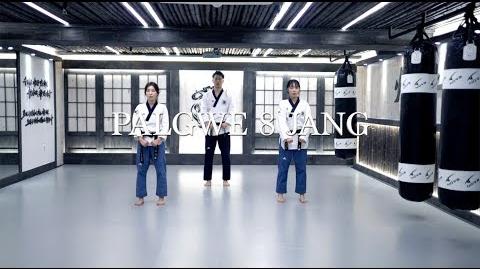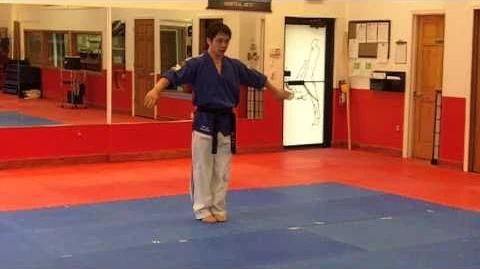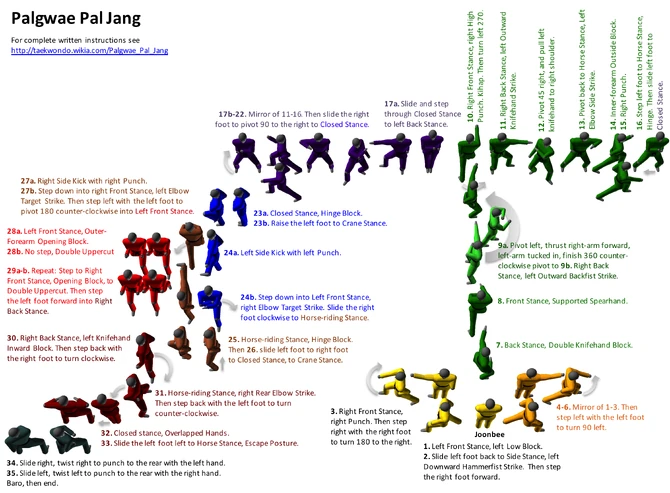Palgwae forms are an older set of poomsae (forms) originally used by the Korean Taekwondo Association in the late 1960s. In the early 1970s these were replaced by the modern taegeuk forms that are still in use in Kukkiwon/ WTF-style taekwondo for all color belts (belts below black).
The palgwae forms are:
- Palgwae Il Jang
- Palgwae Yi Jang also spelled Palgwae Ee Jang
- Palgwae Sam Jang also spelled Palgwae Sahm Jang
- Palgwae Sa Jang also spelled Palgwae Sah Jang
- Palgwae Oh Jang also spelled Palgwae O Jang
- Palgwae Yook Jang also spelled Palgwae Yuk Jang
- Palgwae Chil Jang
- Palgwae Pal Jang also spelled Palgwae Phal Jang
Video[]
Why was this video chosen for use on this wiki? Do you have a better video? Please see Video Guidelines before replacing this video with a better one.
Step-by-step video:
Diagram[]
To print the diagram, click on the image and select "See full size image," or right-click and open the image in a new tab.
Written Instructions[]
- Begin from ready stance (junbi seogi).
- 1. Moving the left foot, step to the left into Left Front Stance (wen apkubi) and execute an Left Low Block (arrae makgi).
- 2. Sliding the left foot back into left stance (wenseogi), execute a Left Hammerfist Strike (mejumeok naeryo chigii).
- 3. Stepping forward into Right Front Stance (oreun apkubi), execute a Right Punch (momtong bandae jireugi).
- 4. Moving the right foot, turn 180° clockwise into Right Front Stance (oreun apkubi) and execute an Right Low Block (i.e., downward block) (arrae makgi).
- 5. Sliding the right foot back into right stance (oreunseogi), execute a Right Hammerfist Strike (mejumeok naeryo chigii).
- 6. Stepping forward into Left Front Stance (wen apkubi), execute a Left Punch (momtong bandae jireugi).
- 7. Moving the left foot, turn 90° counterclockwise into Right Back Stance (i.e., left foot forward, oreun dwitkubi) and execute an Double Knifehand Block (sonnal momtong makgi).
- 8. Step forward with the right foot into Right Front Stance (oreun apkubi) and execute a Right Vertical Fingertip Thrust (pyonsonkkeut sewotzireugi).
- 9a. Push the right hand slightly forward and twist the body counterclockwise.
- 9b. Moving the left foot, turn 180° counterclockwise into Right Back Stance (i.e., left foot forward, oreun dwitkubi) and execute a Left Outward Backfist Strike (deungjumeok bakkat chigii).
- 10. Moving the right foot, step into Right Front Stance (oreun apkubi) and execute a right reverse High punch (olgul bandae jireugi). Kihap.
- 11. Step way back with the left foot to turn 270 counterclockwise into Right Back Stance (i.e., left foot forward, oreun dwitkubi) and execute a Left Outward Knifehand Strike (sonnal bakkat chigii).
- 12. Draw the left foot back slightly and bend the left arm to pull the left knifehand back to in front of the right shoulder.
- 13. Slide the left foot slightly forward into Horse-riding Stance (juchumseogi), executing a Left Elbow Strike (palkup yop chigii).
- 14. Slide the left foot to the left into Left Front Stance (wen apkubi) and execute a Left Outward Block (momtong bakkat makgi).
- 15. Without moving the feet, execute a Right Punch (momtong baro jireugi).
- 16. Turn the body clockwise and step the left foot into Horse-riding Stance (juchumseogi), executing a hinge block (doltzeogi).
- 17a. Bring the left foot to the right foot, making close stance (moaseogi).
- 17b. Slide the right foot forward into Left Back Stance (i.e., right foot forward, wen dwitkubi) and execute a Right Outward Knifehand Strike (sonnal bakkat chigii).
- 18. Draw the right foot back slightly and bend the right arm to pull the right knifehand back to in front of the left shoulder.
- 19. Slide the right foot slightly forward into Horse-riding Stance (juchumseogi), executing a Right Elbow Strike (palkup yop chigii).
- 20. Slide the right foot to the right into Right Front Stance (oreun apkubi) and execute a Right Outward Block (momtong bakkat makgi).
- 21. Without moving the feet, execute a left straight straight punch (momtong baro jireugi).
- 22. Draw the right foot into Horse-riding Stance (juchumseogi) and execute a Right Hinge Block (doltzeogi).
- 23a. Bring the right foot to the left foot, making close stance (moaseogi).
- 23b. Raise the left foot into right Crane Stance (oreun hakdariseogi), continuing to execute a Right Hinge Block (doltzeogi).
- 24a. With the right foot fixed, execute a simultaneous Left Punch (jireugi) and Left Side Kick (wenbal yopchagi).
- 24b. Step down into Left Front Stance (wen apkubi) and execute a Right Elbow Target Strike (palkup pyojeok chigii).
- 25. Moving the left foot, turn 180° clockwise into Horse-riding Stance (juchumseogi) and execute an Left Hinge Block (doltzeogi).
- 26. Raise the right foot into left Crane Stance (wen hakdariseogi), continuing to execute a Left Hinge Block (doltzeogi).
- 27a. With the left foot fixed, execute a simultaneous right punch (jireugi) and Right Side Kick (oreunbal yopchagi).
- 27b. Step down into Right Front Stance (oreun apkubi) and execute a Left Elbow Target Strike (palkup pyojeok chigii).
- 28a. Moving the left foot, turn 180° counterclockwise into Left Front Stance (wen apkubi) and execute an Opening Block (momtong hecho makgi).
- 28b. With the feet fixed, execute a double uppercut (dujumeok jecho jireugi).
- 29a. Stepping forward into Right Front Stance (oreun apkubi), execute an Opening Block (momtong hecho makgi).
- 29b. With the feet fixed, execute a double uppercut (dujumeok jecho jireugi).
- 30. Stepping forward into Right Back Stance (i.e., left foot forward, oreun dwitkubi), execute a Left Knifehand Inward Block (hansonnal momtong an makgi).
- 31. The left hand grabs and twists the opponent’s wrist, pulling it to the waist. Step right with the right foot to turn 180 clockwise into Horse-riding Stance (juchumseogi), and execute a Rear Elbow Strike (palkup dwit chigii).
- 32. Slide the left foot to the right into Overlapping Hands Stance (kyopson moaseogi).
- 33. Move the left foot to the left into Horse-riding Stance (juchumseogi) and execute an Escape Posture (meongeppaegi).
- 34. Sliding the right foot slightly to the right, execute a Right Rear Punch (dwit jireugi).
- 35. Sliding the left foot slightly to the left, execute a Left Rear Punch (dwit jireugi). Kihap.
- Moving the left foot, return to ready stance. If you did everything right, you should wind up back where you started.


